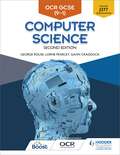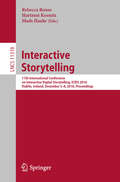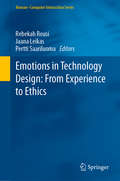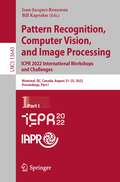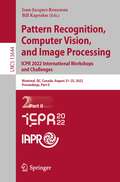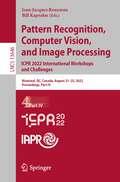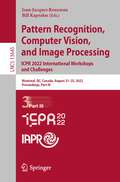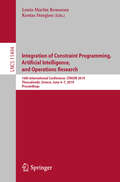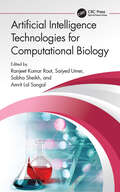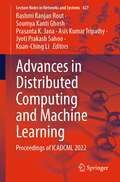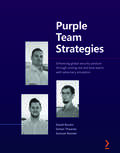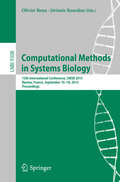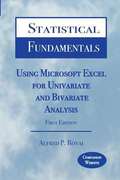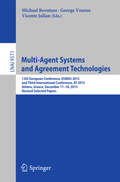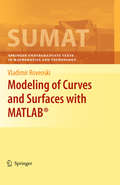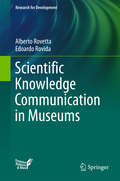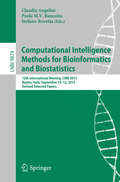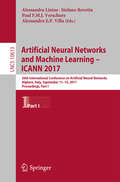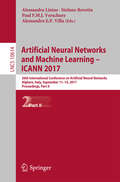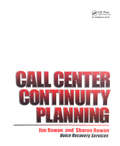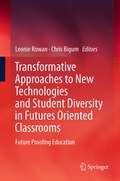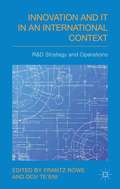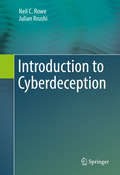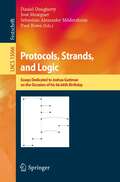- Table View
- List View
OCR GCSE Computer Science, Second Edition
by George Rouse Lorne Pearcey Gavin Craddock Ian PagetWritten by leading Computer Science teachers, this brand-new textbook will guide students through the updated OCR GCSE Computer Science specification topic by topic, and provide them with standalone recap and review sections, worked examples and clear explanations of complex topics.This Student Book:>> develops computational thinking skills in line with the new Practical Programming element of Component 02>> provides differentiated material with the 'beyond the spec' feature>> includes standalone recap and review sections at the end of each chapter>> includes answers to the Knowledge Check questions to support independent learning>> provides definitions of technical terms, along with a glossary of words that will be needed for assessment.Looking for answers for the Student Book? They can be found at the back of the print textbook.You can now access a free set of practice questions on the Hodder Education website. Please note, these questions are not endorsed by OCR and have not been subject to any OCR quality assurance processes.George Rouse, Lorne Pearcey and Gavin Craddock are highly respected and widely published authors of resources.
OCR GCSE Computer Science, Second Edition
by George Rouse Lorne Pearcey Gavin Craddock Ian PagetWritten by leading Computer Science teachers, this brand-new textbook will guide students through the updated OCR GCSE Computer Science specification topic by topic, and provide them with standalone recap and review sections, worked examples and clear explanations of complex topics.This Student Book:>> develops computational thinking skills in line with the new Practical Programming element of Component 02>> provides differentiated material with the 'beyond the spec' feature>> includes standalone recap and review sections at the end of each chapter>> includes answers to the Knowledge Check questions to support independent learning>> provides definitions of technical terms, along with a glossary of words that will be needed for assessment.Looking for answers for the Student Book? They can be found at the back of the print textbook.You can now access a free set of practice questions on the Hodder Education website. Please note, these questions are not endorsed by OCR and have not been subject to any OCR quality assurance processes.George Rouse, Lorne Pearcey and Gavin Craddock are highly respected and widely published authors of resources.
Interactive Storytelling: 11th International Conference on Interactive Digital Storytelling, ICIDS 2018, Dublin, Ireland, December 5–8, 2018, Proceedings (Lecture Notes in Computer Science #11318)
by Rebecca Rouse Hartmut Koenitz Mads HaahrThis book constitutes the refereed proceedings of the 11th International Conference on Interactive Digital Storytelling, ICIDS 2018, held in Dublin, Ireland, in December 2018. The 20 revised full papers and 16 short papers presented together with 17 posters, 11 demos, and 4 workshops were carefully reviewed and selected from 56, respectively 29, submissions. The papers are organized in the following topical sections: the future of the discipline; theory and analysis; practices and games; virtual reality; theater and performance; generative and assistive tools and techniques; development and analysis of authoring tools; and impact in culture and society.
Emotions in Technology Design: From Experience to Ethics (Human–Computer Interaction Series)
by Rebekah Rousi Jaana Leikas Pertti SaariluomaUnderstanding emotions is becoming ever more valuable in design, both in terms of what people prefer as well as in relation to how they behave in relation to it. Approaches to conceptualising emotions in technology design, how emotions can be operationalised and how they can be measured are paramount to ascertaining the core principles of design. Emotions in Technology Design: From Experience to Ethics provides a multi-dimensional approach to studying, designing and comprehending emotions in design. It presents emotions as understood through basic human-technology research, applied design practice, culture and aesthetics, ethical approaches to emotional design, and ethics as a cultural framework for emotions in design experience. Core elements running through the book are: cognitive science – cognitive-affective theories of emotions (i.e., Appraisal); culture – the ways in which our minds are trained to recognise, respond to and influence design; and ethics – a deep cultural framework of interpretations of good versus evil. This ethical understanding brings culture and cognition together to form genuine emotional experience. This book is essential reading for designers, technology developers, HCI and cognitive science scholars, educators and students (at both undergraduate and graduate levels) in terms of emotional design methods and tools, systematic measurement of emotion in design experience, cultural theory underpinning how emotions operate in the production and interaction of design, and how ethics influence basic (primal) and higher level emotional reactions. The broader scope equips design practitioners, developers and scholars with that ‘something more’ in terms of understanding how emotional experience of technology can be positioned in relation to cultural discourse and ethics.
Pattern Recognition, Computer Vision, and Image Processing. ICPR 2022 International Workshops and Challenges: Montreal, QC, Canada, August 21–25, 2022, Proceedings, Part I (Lecture Notes in Computer Science #13643)
by Jean-Jacques Rousseau Bill KapralosThis 4-volumes set constitutes the proceedings of the ICPR 2022 Workshops of the 26th International Conference on Pattern Recognition Workshops, ICPR 2022, Montreal, QC, Canada, August 2023. The 167 full papers presented in these 4 volumes were carefully reviewed and selected from numerous submissions. ICPR workshops covered domains related to pattern recognition, artificial intelligence, computer vision, image and sound analysis. Workshops’ contributions reflected the most recent applications related to healthcare, biometrics, ethics, multimodality, cultural heritage, imagery, affective computing, etc.
Pattern Recognition, Computer Vision, and Image Processing. ICPR 2022 International Workshops and Challenges: Montreal, QC, Canada, August 21–25, 2022, Proceedings, Part II (Lecture Notes in Computer Science #13644)
by Jean-Jacques Rousseau Bill KapralosThis 4-volumes set constitutes the proceedings of the ICPR 2022 Workshops of the 26th International Conference on Pattern Recognition Workshops, ICPR 2022, Montreal, QC, Canada, August 2023. The 167 full papers presented in these 4 volumes were carefully reviewed and selected from numerous submissions. ICPR workshops covered domains related to pattern recognition, artificial intelligence, computer vision, image and sound analysis. Workshops’ contributions reflected the most recent applications related to healthcare, biometrics, ethics, multimodality, cultural heritage, imagery, affective computing, etc.
Pattern Recognition, Computer Vision, and Image Processing. ICPR 2022 International Workshops and Challenges: Montreal, QC, Canada, August 21–25, 2022, Proceedings, Part IV (Lecture Notes in Computer Science #13646)
by Jean-Jacques Rousseau Bill KapralosThis 4-volumes set constitutes the proceedings of the ICPR 2022 Workshops of the 26th International Conference on Pattern Recognition Workshops, ICPR 2022, Montreal, QC, Canada, August 2023. The 167 full papers presented in these 4 volumes were carefully reviewed and selected from numerous submissions. ICPR workshops covered domains related to pattern recognition, artificial intelligence, computer vision, image and sound analysis. Workshops’ contributions reflected the most recent applications related to healthcare, biometrics, ethics, multimodality, cultural heritage, imagery, affective computing, etc.
Pattern Recognition, Computer Vision, and Image Processing. ICPR 2022 International Workshops and Challenges: Montreal, QC, Canada, August 21–25, 2022, Proceedings, Part III (Lecture Notes in Computer Science #13645)
by Jean-Jacques Rousseau Bill KapralosThis 4-volumes set constitutes the proceedings of the ICPR 2022 Workshops of the 26th International Conference on Pattern Recognition Workshops, ICPR 2022, Montreal, QC, Canada, August 2023. The 167 full papers presented in these 4 volumes were carefully reviewed and selected from numerous submissions. ICPR workshops covered domains related to pattern recognition, artificial intelligence, computer vision, image and sound analysis. Workshops’ contributions reflected the most recent applications related to healthcare, biometrics, ethics, multimodality, cultural heritage, imagery, affective computing, etc.
Integration of Constraint Programming, Artificial Intelligence, and Operations Research: 16th International Conference, CPAIOR 2019, Thessaloniki, Greece, June 4–7, 2019, Proceedings (Lecture Notes in Computer Science #11494)
by Louis-Martin Rousseau Kostas StergiouThis book constitutes the proceedings of the 16th International Conference on Integration of Constraint Programming, Artificial Intelligence, and Operations Research, CPAIOR 2019, held in Thessaloniki, Greece, in June 2019.The 34 full papers presented together with 9 short papers were carefully reviewed and selected from 94 submissions. The conference brings together interested researchers from Constraint Programming (CP), Artificial Intelligence (AI), and Operations Research (OR) to present new techniques or applications and to provide an opportunity for researchers in one area to learn about techniques in the others. A main objective of this conference series is also to give these researchers the opportunity to show how the integration of techniques from different fields can lead to interesting results on large and complex problems.
Artificial Intelligence Technologies for Computational Biology
by Ranjeet Kumar Rout Saiyed Umer Sabha Sheikh Amrit Lal SangalThis text emphasizes the importance of artificial intelligence techniques in the field of biological computation. It also discusses fundamental principles that can be applied beyond bio-inspired computing.It comprehensively covers important topics including data integration, data mining, machine learning, genetic algorithms, evolutionary computation, evolved neural networks, nature-inspired algorithms, and protein structure alignment. The text covers the application of evolutionary computations for fractal visualization of sequence data, artificial intelligence, and automatic image interpretation in modern biological systems.The text is primarily written for graduate students and academic researchers in areas of electrical engineering, electronics engineering, computer engineering, and computational biology.This book:• Covers algorithms in the fields of artificial intelligence, and machine learning useful in biological data analysis.• Discusses comprehensively artificial intelligence and automatic image interpretation in modern biological systems.• Presents the application of evolutionary computations for fractal visualization of sequence data.• Explores the use of genetic algorithms for pair-wise and multiple sequence alignments.• Examines the roles of efficient computational techniques in biology.
Advances in Distributed Computing and Machine Learning: Proceedings of ICADCML 2022 (Lecture Notes in Networks and Systems #427)
by Rashmi Ranjan Rout Soumya Kanti Ghosh Prasanta K. Jana Asis Kumar Tripathy Jyoti Prakash Sahoo Kuan-Ching LiThis book includes a collection of peer-reviewed best selected research papers presented at the Third International Conference on Advances in Distributed Computing and Machine Learning (ICADCML 2022), organized by Department of Computer Science and Engineering, National Institute of Technology, Warangal, Telangana, India, during 15–16 January 2022. This book presents recent innovations in the field of scalable distributed systems in addition to cutting edge research in the field of Internet of Things (IoT) and blockchain in distributed environments.
Purple Team Strategies: Enhancing global security posture through uniting red and blue teams with adversary emulation
by David Routin Simon Thoores Samuel RossierLeverage cyber threat intelligence and the MITRE framework to enhance your prevention mechanisms, detection capabilities, and learn top adversarial simulation and emulation techniquesKey FeaturesApply real-world strategies to strengthen the capabilities of your organization's security systemLearn to not only defend your system but also think from an attacker's perspectiveEnsure the ultimate effectiveness of an organization's red and blue teams with practical tipsBook DescriptionWith small to large companies focusing on hardening their security systems, the term "purple team" has gained a lot of traction over the last couple of years. Purple teams represent a group of individuals responsible for securing an organization's environment using both red team and blue team testing and integration – if you're ready to join or advance their ranks, then this book is for you.Purple Team Strategies will get you up and running with the exact strategies and techniques used by purple teamers to implement and then maintain a robust environment. You'll start with planning and prioritizing adversary emulation, and explore concepts around building a purple team infrastructure as well as simulating and defending against the most trendy ATT&CK tactics. You'll also dive into performing assessments and continuous testing with breach and attack simulations.Once you've covered the fundamentals, you'll also learn tips and tricks to improve the overall maturity of your purple teaming capabilities along with measuring success with KPIs and reporting.With the help of real-world use cases and examples, by the end of this book, you'll be able to integrate the best of both sides: red team tactics and blue team security measures.What you will learnLearn and implement the generic purple teaming processUse cloud environments for assessment and automationIntegrate cyber threat intelligence as a processConfigure traps inside the network to detect attackersImprove red and blue team collaboration with existing and new toolsPerform assessments of your existing security controlsWho this book is forIf you're a cybersecurity analyst, SOC engineer, security leader or strategist, or simply interested in learning about cyber attack and defense strategies, then this book is for you. Purple team members and chief information security officers (CISOs) looking at securing their organizations from adversaries will also benefit from this book. You'll need some basic knowledge of Windows and Linux operating systems along with a fair understanding of networking concepts before you can jump in, while ethical hacking and penetration testing know-how will help you get the most out of this book.
Computational Methods in Systems Biology: 13th International Conference, CMSB 2015, Nantes, France, September 16-18, 2015, Proceedings (Lecture Notes in Computer Science #9308)
by Olivier Roux Jérémie BourdonThis book constitutes the refereed proceedings of the 13th International Conference on Computational Methods in Systems Biology, CMSB 2015, held in Nantes, France, in September 2015. The 20 full papers and 2 short papers presented were carefully reviewed and selected from 43 full and 4 short paper submissions. The papers cover a wide range of topics in the analysis of biological systems, networks and data such as model checking, stochastic analysis, hybrid systems, circadian clock, time series data, logic programming, and constraints solving ranging from intercellular to multiscale.
Statistical Fundamentals: Using Microsoft Excel for Univariate and Bivariate Analysis
by Alfred P. RovaiThe purpose of this book is to provide a working background of descriptive and inferential statistics and step-by-step examples of how to perform various statistical procedures using Microsoft Excel's native operators and functions. Automated procedures are also described using Excel's Analysis TookPak and AnalystSoft StatPlus.
Multi-Agent Systems and Agreement Technologies
by Michael Rovatsos George Vouros Vicente JulianThis book constitutes the revised selected papers from the 13 European Conference on Multi-Agent Systems, EUMAS 2015, and the Third International Conference on Agreement Technologies, AT 2015, held in Athens, Greece, in December 2015. The 36 papers presented in this volume were carefully reviewed and selected from 65 submissions. They are organized in topical sections named: coordination and planning; learning and optimization, argumentation and negotiation; norms, trust, and reputation; agent-based simulation and agent programming.
Modeling of Curves and Surfaces with MATLAB®
by Vladimir RovenskiThis text on geometry is devoted to various central geometrical topics including: graphs of functions, transformations, (non-)Euclidean geometries, curves and surfaces as well as their applications in a variety of disciplines. This book presents elementary methods for analytical modeling and demonstrates the potential for symbolic computational tools to support the development of analytical solutions. The author systematically examines several powerful tools of MATLAB® including 2D and 3D animation of geometric images with shadows and colors and transformations using matrices. With over 150 stimulating exercises and problems, this text integrates traditional differential and non-Euclidean geometries with more current computer systems in a practical and user-friendly format. This text is an excellent classroom resource or self-study reference for undergraduate students in a variety of disciplines.
Scientific Knowledge Communication in Museums (Research For Development Ser.)
by Alberto Rovetta Edoardo RovidaThis book explains the general principles of scientific and technical communication in the context of modern museums. It also examines, with the aid of informative case studies, the different means by which knowledge can be transmitted, including posters, objects, explanatory guidance, documentation, and catalogues. Highlighting the ever more important role of multimedia and virtual reality components in communicating understanding of and facilitating interaction with the displayed object, it explores how network communications systems and algorithms can be applied to offer individual users the information that is most pertinent to them. The book is supported by a Dynamic Museums app connected to museum databases where series of objects can be viewed via cloud computing and the Internet and printed using 3D printing technology. This book is of interest to a diverse readership, including all those who are responsible for museums’ collections, operations, and communications as well as those delivering or participating in courses on museums and their use, communication design and related topics.
Computational Intelligence Methods for Bioinformatics and Biostatistics: 12th International Meeting, CIBB 2015, Naples, Italy, September 10-12, 2015, Revised Selected Papers (Lecture Notes in Computer Science #9874)
by Stefano Rovetta Claudia Angelini Paola M. V. RancoitaThis book constitutes the thoroughly refereed post-conference proceedings of the 12th International Meeting on Computational Intelligence Methods for Bioinformatics and Biostatistics, CIBB 2015, held in Naples, Italy, in September, 2015. The 21 revised full papers presented were carefully reviewed and selected from 24 submissions. They present problems concerning computational techniques in bioinformatics, systems biology and medical informatics discussing cutting edge methodologies and accelerate life science discoveries, as well as novel challenges with an high impact on molecular biology and translational medicine.
Artificial Neural Networks and Machine Learning – ICANN 2017: 26th International Conference on Artificial Neural Networks, Alghero, Italy, September 11-14, 2017, Proceedings, Part I (Lecture Notes in Computer Science #10613)
by Stefano Rovetta Paul F.M.J. Verschure Alessandro E.P. Villa Alessandra LintasThe two volume set, LNCS 10613 and 10614, constitutes the proceedings of then 26th International Conference on Artificial Neural Networks, ICANN 2017, held in Alghero, Italy, in September 2017. The 128 full papers included in this volume were carefully reviewed and selected from 270 submissions. They were organized in topical sections named: From Perception to Action; From Neurons to Networks; Brain Imaging; Recurrent Neural Networks; Neuromorphic Hardware; Brain Topology and Dynamics; Neural Networks Meet Natural and Environmental Sciences; Convolutional Neural Networks; Games and Strategy; Representation and Classification; Clustering; Learning from Data Streams and Time Series; Image Processing and Medical Applications; Advances in Machine Learning. There are 63 short paper abstracts that are included in the back matter of the volume.
Artificial Neural Networks and Machine Learning – ICANN 2017: 26th International Conference on Artificial Neural Networks, Alghero, Italy, September 11-14, 2017, Proceedings, Part II (Lecture Notes in Computer Science #10614)
by Stefano Rovetta Paul F.M.J. Verschure Alessandro E.P. Villa Alessandra LintasThe two volume set, LNCS 10613 and 10614, constitutes the proceedings of then 26th International Conference on Artificial Neural Networks, ICANN 2017, held in Alghero, Italy, in September 2017. The 128 full papers included in this volume were carefully reviewed and selected from 270 submissions. They were organized in topical sections named: From Perception to Action; From Neurons to Networks; Brain Imaging; Recurrent Neural Networks; Neuromorphic Hardware; Brain Topology and Dynamics; Neural Networks Meet Natural and Environmental Sciences; Convolutional Neural Networks; Games and Strategy; Representation and Classification; Clustering; Learning from Data Streams and Time Series; Image Processing and Medical Applications; Advances in Machine Learning. There are 63 short paper abstracts that are included in the back matter of the volume.
Call Center Continuity Planning
by Jim RowanA disruption in your call center operation can conceivably cost you hundreds of thousands of dollars. And multiple disruptions can cost in the millions. Call Center Continuity Planning shows you how to plan for - and avoid - service interruptions through disasters large and small. This book will show you how to deal with everything from power outag
Transformative Approaches to New Technologies and Student Diversity in Futures Oriented Classrooms
by Leonie Rowan Chris BigumIn this book we outline an optimistic, aspirational and unashamedly ambitious agenda for schooling. We make cautious use of the concept of 'future proofing' to signal the commitment of the various authors to re-thinking the purposes, content and processes of schooling with a view to ensuring that all children, from all backgrounds are prepared by their education to make a positive contribution to the futures that are ahead of them. The book focuses on issues relating to technology and social justice to re-examine the traditional relationship between schools and technology, between schools and diverse learners, and between schools, children and knowledge. Drawing from examples from around the world, the book explores practical ways that diverse schools have worked to celebrate diverse understandings of what it means to be a learner, a citizen, a worker in these changed and changing times and the ways different technologies can support this agenda.
Innovation and IT in an International Context
by Frantz Rowe Dov Te�eniInnovation and IT are intertwined. In order to understand how, Innovation and IT in an International Context takes an interdisciplinary view of innovation in an international and digital world. It addresses strategic and operational aspects of R&D and new product development, emphasizing knowledge management, configurational design, distance and diversity. From an economics and strategic management perspective, its first chapters deal with degree of openness, distance and specialization, and examine innovative performance in terms of patents, mergers and acquisition and exports. The second section takes a configurational approach, either at a theoretical level for general design, or in a managerial way for implementing Product Lifecycle Management systems. It also treats coordination and productivity issues. In the third part, which considers the operational level, the issues of diversity and distance are addressed more specifically and in an international context.
Introduction to Cyberdeception
by Neil C. Rowe Julian RrushiThis book is an introduction to both offensive and defensive techniques of cyberdeception. Unlike most books on cyberdeception, this book focuses on methods rather than detection. It treats cyberdeception techniques that are current, novel, and practical, and that go well beyond traditional honeypots. It contains features friendly for classroom use: (1) minimal use of programming details and mathematics, (2) modular chapters that can be covered in many orders, (3) exercises with each chapter, and (4) an extensive reference list. Cyberattacks have grown serious enough that understanding and using deception is essential to safe operation in cyberspace. The deception techniques covered are impersonation, delays, fakes, camouflage, false excuses, and social engineering. Special attention is devoted to cyberdeception in industrial control systems and within operating systems. This material is supported by a detailed discussion of how to plan deceptions and calculate their detectability and effectiveness. Some of the chapters provide further technical details of specific deception techniques and their application. Cyberdeception can be conducted ethically and efficiently when necessary by following a few basic principles. This book is intended for advanced undergraduate students and graduate students, as well as computer professionals learning on their own. It will be especially useful for anyone who helps run important and essential computer systems such as critical-infrastructure and military systems.
Protocols, Strands, and Logic: Essays Dedicated to Joshua Guttman on the Occasion of his 66.66th Birthday (Lecture Notes in Computer Science #13066)
by Paul Rowe José Meseguer Daniel Dougherty Sebastian Alexander MödersheimThis Festschrift was published in honor of Joshua Guttman on the occasion of his 66.66 birthday. The impact of his work is reflected in the 23 contributions enclosed in this volume. Joshua’s most influential and enduring contribution to the field has been the development of the strand space formalism for analyzing cryptographic protocols. It is one of several “symbolic approaches” to security protocol analysis in which the underlying details of cryptographic primitives are abstracted away, allowing a focus on potential flaws in the communication patterns between participants. His attention to the underlying logic of strand spaces has also allowed him to merge domain-specific reasoning about protocols with general purpose, first-order logical theories. The identification of clear principles in a domain paves the way to automated reasoning, and Joshua has been a leader in the development and distribution of several tools for security analysis.
